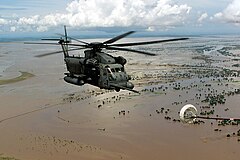2000 Mozambique flood

American helicopter flying over flooded Limpopo River in Mozambique
|
|
| Date | February-March 2000 |
|---|---|
| Location | Southern Mozambique |
| Deaths | 700-800 |
| Property damage | $500 million (2000 US$) |
The 2000 Mozambique flood was a natural disaster that occurred in February and March 2000. The catastrophic flooding was caused by heavy rainfall that lasted for five weeks and made many homeless. Approximately 700 people were killed. 1,400 km² of arable land was affected and 20,000 herds of cattle were lost. It was the worst flood in Mozambique in 50 years.
It started in South Africa when heavy rain falls traveled over to Mozambique. It caused dozens of deaths. 44,000 were left homeless and many of them had lost relatives of some kind. Later, Cyclone Eline came and destroyed many more homes and lives. The women and children were hurrying to shelter and high land. 800 had died and thousands of livestock were killed. The government distributed 15 million dollars to its citizens to account for damage property and loss of income. Even now in 2016, people are still living in recovery shelters with fluctuating water supplies.
In October and November 1999, heavy rainfall affected Mozambique, followed by a period of heavy rainfall in January 2000. By the end of January 2000, the rains caused the Incomati, the Umbeluzi, and the Limpopo rivers to exceed their banks, inundating portions of the capital Maputo. At Chókwè, the Limpopo River reached a level 6 m (20 ft) above normal on January 24, twice its normal level. Some areas received a year's worth of rainfall in two weeks. The resultant floods were considered the worst to affect the nations since 1951.
Flooding was beginning to recede in late February by the time Cyclone Eline made landfall. Eline was a long-lasting tropical cyclone that struck near Beira at peak intensity on February 22. By the end of February 2000, the situation was considered the country's worst natural disaster in a century.
By late January, the flooding had already caused increases in malaria and diarrhea. Flooding also disrupted water supply and covered roads, with the primary north-south highway cut in three locations. Widespread areas were inundated, which displaced about 220,000 people, and killed about 150 people before Eline struck.
...
Wikipedia
